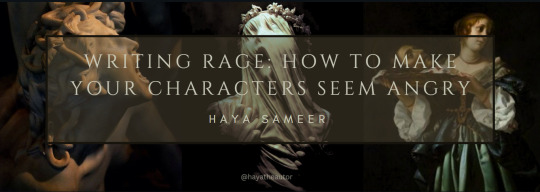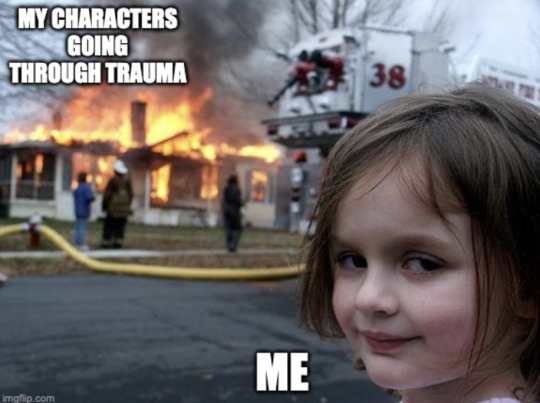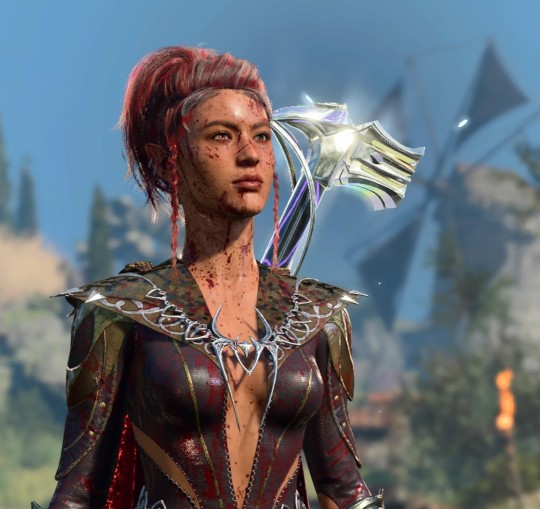#Tips for Authors
Text
If you are writing a book and you are describing something that is all knowing, the word you need to use is omniscient, not omnipotent.
Omnipotent is all powerful
Omniscient is all knowing.
#writing#book#writing books#goddesses#gods#deities#omnipotent#omniscient#FUCKING USE THE RIGHT GODS DAMNED WORD!!!#author#authors#writerscommunity#writers#writer#writing tips#book writing#book writing tips#tips for authors#get a fucking dictionary.#rant
5 notes
·
View notes
Text
Top tips on how to (anonymously) share the love for the fics!
One thing we’ve heard in past rounds is that authors are afraid to comment on other fics while the event is live incase it narrows down people’s guessing for their own fics - which is completely valid! But the other thing we’ve heard is that despite good intentions to come back after the reveal and leave comments, it doesn’t often happen for a variety of reasons.
Enter: Guest comments
Open up that fic in your private browsing tab, or incognito mode, where you won’t be logged into AO3 - you are now free to safely leave an anonymous kudos and leave a comment about things you enjoyed in the fic without it being linked to your AO3 profile. If you are worried about missing an author’s reply, don’t be - guest comments have to leave an email address. NOBODY sees this email address, AO3 use it purely to email you if an author replies.
This can also work if you’re feeling shy about commenting on a fic at any time!
🎭Feel empowered to go forth and spread the love!💛🧡💜
#tua masked author#3ma#the umbrella academy#tua fandom#tua#tips for readers#tips for authors#share the love <3
23 notes
·
View notes
Text
Context is everything
Context is everything
https://creativeramblings.com/ramblings/context/
Photo credit: 愚木混株 Cdd20 via Pixabay
When Threads arrived on the scene last year, the honeymoon phase was wonderful. People were excited to be there and very good conversations were happening.
And then, all hell broke loose. Since then, there has not been a day without drama. Many people with very poor knowledge of or limited experience in publishing spread misinformation constantly. Their…

View On WordPress
0 notes
Text
want your favorite author to update but don’t want to be too pushy in their comment section?
here’s 5 things you can do to encourage them:
Reblog their fic link on tumblr (bonus if it’s with tags)
Bookmark the fic with a note about what you’re excited about/love in the fic
Recommend the fic to your friends or local discord channel
Draw art or create other media for the fic (as indicated by the author’s comfort level)
Leave them a comment when re-reading about the parts of the chapter/story that stood out to you the second time
#this isn’t about me#this is just what I think a lot of authors would appreciate#more than the ‘update soon!!!’ comments#fic#fanfic#fanfiction#ao3#archive of our own#writing things#writing#reading things#reading#tips and tricks
33K notes
·
View notes
Text
Some of my writer’s block cures:
Handwrite. (If you already are, write in a different coloured pen.)
Write outside or at a different location.
Read.
Look up some writing prompts.
Take a break. Do something different. Comeback to it later.
Write something else. (A different WIP, a poem, a quick short story, etc.)
Find inspiring writing music playlists on YouTube. (Themed music, POV playlists, ambient music, etc.)
Do some character or story prompts/questions to get a better idea of who or what you’re writing.
Word sprints. Set a timer and write as much as you can. Not a lot of time to overthink things.
Set your own goals and deadlines.
Write another scene from your WIP. (You don’t have to write in order.) Write a scene you want to write, or the ending. (You can change it or scrap it if it doesn’t fit into your story later.)
Write a scene for your WIP that you will never post/add to your story. A prologue, a different P.O.V., how your characters would react in a situation that’s not in your story, a flashback, etc.
Write down a bunch of ideas. Things that could happen, thing that will never happen, good things, bad things.
Change the weather (in the story of course.)
Feel free to add your own.
#writeblr#writing help#writing tips#writing advice#books#writing#wattpad#stories#author#writing community#creative writing#writers on tumblr#writers block#writers blog#writblr#female writers#writerscorner#writing motivation#writers block cures#novel writing#writer things#writing encouragement#authors supporting authors#author blog
13K notes
·
View notes
Text
Writing Tips Master Post
Character writing/development:
Character Arcs
Making Character Profiles
Character Development
Comic Relief Arc
Internal Conflict
Creating Distinct Characters
Suicidal Urges/Martyr Complex
Creating Likeable Characters
Writing Strong Female Characters
Writing POC Characters
Character Voices
Plot devices/development:
Intrigue in Storytelling
Enemies to Lovers
Alternatives to Killing Characters
Worldbuilding
Misdirection
Consider Before Killing Characters
Foreshadowing
Narrative:
Emphasising the Stakes
Avoid Info-Dumping
Writing Without Dialogue
1st vs. 2nd vs. 3rd Perspective
Fight Scenes (More)
Transitions
Pacing
Dialogue Tips
Writing Cheating
Book writing:
Connected vs. Stand-Alone Series
A & B Stories
Writer resources:
Writing YouTube Channels, Podcasts, & Blogs
Online Writing Resources
Outlining/Writing/Editing Software
Writer help:
Losing Passion/Burnout
Overcoming Writer's Block
Fantasy terms:
How To Name Fantasy Races (Step-by-Step)
Naming Elemental Races
Naming Fire-Related Races
Ask games:
Character Ask Game #1
Character Ask Game #2
Miscellaneous:
1000 Follower Special
Writing Fantasy
#masterlist#masterpost#writeblr#writing#writing tips#writing advice#writing help#writing resources#author resources#writer resources#creative writing#character writing#character development#plot development#narrative#book writing#writers block#writer stuff#writer things#deception-united
7K notes
·
View notes
Text
What Is Your Writing Goal
Truly every author should know the answer to the question, What is your writing goal? It sounds so simple but for most of us it really isn’t. Take a few minutes and write down some reason why you are writing your current work-in-progress (WIP). Think of nothing else for now. Just a simple one or two sentence response will do. It really doesn’t matter what your reasons are for writing this…

View On WordPress
#Fiction and NonFiction Writer Motivations#Get Going on Your Writing#No One Can Stop You But You#One Strategy to Get More Readers#SMART Goals for Writers#Some Ideas to Increase Book Sales#Tips for Authors#What Is Your Writing Goal
1 note
·
View note
Text
Body language cues for a few emotions
Happiness:
Smiling genuinely, with crinkles around the eyes.
Open body posture, with relaxed arms and shoulders.
Leaning forward slightly towards the person or object of interest.
Making eye contact with a warm and engaged expression.
Anger:
Tightened jaw and clenched fists.
Furrowed brows and narrowed eyes.
Standing or sitting with a rigid and tense posture.
Pointing fingers or aggressive gestures.
Raised voice or speaking through gritted teeth.
Sadness:
Downcast eyes and a drooping posture.
Slumped shoulders and shallow breathing.
Avoiding eye contact and withdrawing from social interaction.
Sighing or a subdued tone of voice.
Tearfulness, with watery or red eyes.
Fear:
Widened eyes with dilated pupils.
Raised eyebrows and a tense facial expression.
Frozen or rigid body posture.
Backing away or seeking physical distance from the perceived threat.
Trembling or shaking, especially in the hands or legs.
Surprise:
Raised eyebrows and widened eyes.
Mouth slightly agape or forming an "O" shape.
Leaning forward or recoiling backward in response to the surprise.
Quick inhalation or gasp of breath.
Rapid blinking or blinking more than usual.
Disgust:
Curling the upper lip or wrinkling the nose.
Narrowing the eyes and raising the upper eyelids.
Turning the head away or physically distancing oneself from the source of disgust.
Covering the mouth or nose with the hand or a tissue.
Expressing verbal disgust through phrases like "ew" or "yuck."
These are just some examples, and individuals may display variations in their body language based on their personality, cultural background, and the specific context of the situation.
#writing#writer on tumblr#writerscommunity#writing tips#character development#creative writing#body language#writing characters#writers on tumblr#authors of tumblr
2K notes
·
View notes
Text
Writing Rage: How To Make Your Characters Seem Angry

Anger is a powerful emotion that can add depth and intensity to your character's personality. If you're facing issues realistically expressing your characters' rage, here are some quick tips to help you get the ball rolling. Whether your character is seething with quiet rage or exploding in a fit of fury, these tips will help you convey their emotions vividly to your readers.
This is blog one in my writing different emotions series. Go check it out to explore more emotions!
Facial Expressions
Furrowed Brows: Describe the deep lines between their eyebrows, signaling frustration or intensity.
Tightened Jaw: Mention their clenched jaw, indicating suppressed anger or tension.
Narrowed Eyes: Highlight how their eyes narrow, showing suspicion, irritation, or anger.
Raised Upper Lip: Note the slight curl of the lip, suggesting disdain or contempt.
Flared Nostrils: Describe how their nostrils flare, indicating heightened emotions like anger or aggression.
Body Language and Gestures
Crossed Arms: Show their defensive stance, portraying resistance or defiance.
Pointing Finger: Describe them pointing accusatively, conveying aggression or assertion.
Fist Clenching: Mention their clenched fists, symbolizing anger or readiness for confrontation.
Hand Gestures: Detail specific hand movements like chopping motions, indicating frustration or emphasis.
Aggressive Posturing: Describe them leaning forward, invading personal space to intimidate or assert dominance.
Posture
Tense Shoulders: Highlight their raised or tense shoulders, indicating stress or readiness for conflict.
Upright Stance: Describe their rigid posture, showing control or a desire to appear strong.
Stiff Movements: Mention their jerky or abrupt movements, reflecting agitation or impatience.
Eye Contact
Intense Stares: Describe their intense or prolonged gaze, signaling confrontation or challenge.
Avoiding Eye Contact: Note how they avoid eye contact, suggesting discomfort or a desire to disengage.
Glaring: Mention how they glare at others, conveying hostility or disapproval.
Dialogue
Raised or strained tone with variations in pitch reflects heightened emotions.
Short, clipped sentences or abrupt pauses convey controlled anger.
Use of profanity or harsh language intensifies verbal expressions of anger.
Volume increase, from whispers to shouts, mirrors escalating anger levels.
Monotonous or sarcastic tone adds layers to angry dialogue.
Interruptions or talking over others signify impatience and frustration.
Aggressive verbal cues like "I can't believe..." or "How dare you..." express anger explicitly.
Reactions
Physical Reactions: Detail physical responses like increased heart rate, sweating, or trembling, showing emotional arousal.
Defensive Maneuvers: Describe how they react defensively if someone tries to touch or talk to them, such as stepping back or raising a hand to ward off contact.
Object Interaction
Aggressive Handling: Show them slamming objects, throwing things, or gripping items tightly, reflecting anger or aggression.
Use of Props: Mention how they use objects to emphasize their emotions, like slamming a door or clenching a pen.
Descriptive Words:
Verbs:
Roared with fury, expressing unbridled anger.
Snapped in frustration, indicating sudden irritation.
Shouted angrily, releasing pent-up emotions.
Glared fiercely, showing intense displeasure.
Slammed objects in rage, symbolizing anger's physical manifestation.
Grunted in annoyance, displaying impatience.
Raged vehemently, portraying uncontrolled anger.
Adjectives:
Furious and incensed, conveying intense anger.
Seething with rage, bubbling beneath the surface.
Livid and fuming, exhibiting visible anger.
Agitated and irritated, showing growing impatience.
Enraged and wrathful, expressing extreme anger.
Vexed and irate, indicating annoyance.
Infuriated and incandescent, highlighting explosive anger.
Looking For More Writing Tips And Tricks?
Are you an author looking for writing tips and tricks to better your manuscript? Or do you want to learn about how to get a literary agent, get published and properly market your book? Consider checking out the rest of Haya’s book blog where I post writing and publishing tips for authors every Monday and Thursday! And don’t forget to head over to my TikTok and Instagram profiles @hayatheauthor to learn more about my WIP and writing journey!
#hayatheauthor#haya sameer#haya's book blog#haya blogs#blog masterlist#writing community#writing tools#writer things#writing advice#writer community#writing techniques#writing prompt#writing stuff#creative writing#ya writing advice#writing tips and tricks#writer tools#writers of tumblr#writer blog#writers block#writers on tumblr#writerscommunity#writer stuff#author help#author advice#writing emotions#how to write emotions#emotional writing#writing#author
2K notes
·
View notes
Text
What If I've Outgrown My Story?
Embracing Change and Rediscovering Your Passion for Writing
As authors, we pour our hearts and souls into our stories. We create characters, weave intricate plots, and build worlds from the ground up. But what happens when you’ve spent so much time and effort on a story, only to realize that you’ve outgrown it? In this article, I’ll share my personal experience with this dilemma and provide some…

View On WordPress
#Creative writing#Personal growth#Rewriting#storytelling#Tips for Authors#Writer&039;s block#Writing process#Writing tips
0 notes
Text
Storyediting Questions to Ask
As You Read the First Draft:
Are there place that surprised you as you read your first draft?
- Why do you suppose that is?
- Is there material there you'd like to expand?
What are the character really doing in this story?
- Might they have issues you haven't explored fully yet?
Look to the places that drag.
- These might be scenes where you have avoided dealing with something deeper.
- What are the characters really thinking in these places?
- What are their passions, frustrations, and desires?
Imagine alternative plotlines.
- How might your plot be different if ti headed off on another tangent from various points in the story?
- You don't have to follow them, but they might suggest other streams that can flow into the main plot.
Think About Structure:
Does you story play out naturally in three acts?
Is there an immediate disturbance to the Lead's world?
Does the first doorway of no return occur before the one-fifth mark?
Are the stakes being raised sufficiently?
Does the second doorway of no return put the Lead on the path to the climax?
Does the rhythm of the sotyr match your intent? If this is an action novel, does the plot move relentlessly forward? If this is a character-driven novel, do the scenes delve deeply enough?
Are there strongly motivated characters?
Have coincidence been established?
Is something happeing immediately at the beginning? Did you establish a person in a setting with a problem, onfronted with change or threat?
Is the timeline logical?
Is the story too predictable in terms of sequence? Should it be rearranged?
About Your Lead Character:
Is the character memorable? Compelling? Enough to carry a reader all the way through the plot?
A lead character has to jump off the page. Does yours?
Does this character avoid cliches? Is he capable of surprising us?
What's unique about the character?
Is the character's objective strong enough?
How does the character grow over the course of the story?
How does the character demonstrate inner strength?
About Your Opposition:
Is your oppositing character interesting?
Is he fully realized, not just a cardboard cutout?
Is he justified (at least in his own mind) in his actions?
Is he believable?
Is he strong as or stronger than the Lead?
About Your Story's Adhesive Nature:
Is the conflcit between the Lead and opposition crucial for both?
Why can't they just walk away? What holds them together?
About Your Scene:
Are the big scenes big enough? Surprising enough? Can you make them more original, unanticipated, and draw them out for all they are worth?
Is there enough conflict in the scenes?
What is the least memorable scene? Cut it!
What else can be cut in order to move the story relentlessly forward?
Does the climactic scene come too fast (through a writer fatigue)? Can you make it more, write it for all it's worth?
Does we need a new minor subplot to build up a saggin midsection?
About Your Minor Characters:
What is their purpose in the plot?
Are they unique and colorful?
Polishing Questions:
Are you hooking the reader from the beginning?
Are suspenseful scenes drawn out for the ultimate tension?
Can any information be delayed? This creates tension in the reader, always a good thing.
Are there enough surprises?
Are character-reaction scenes deep and interesting?
Read chapter ending for read-on prompts
Are there places you can replace describing how a character feels with actions?
Do I use visual, sensory-laden words?
For a Dialogue Read-Through:
Dialogue is almost always strengthened by cutting words within the lines.
In dialogue, be fair to both sides. Don't give one character all the good lines.
Greate dialogue surprises the reader and creates tension. View it like a game, where the players are trying to outfox each other.
Can you get more conflict into dialogue, even emong allies?
If you like my blog, buy me a coffee☕ and find me on instagram! 📸
#writers and poets#writing#creative writing#poets and writers#writers on tumblr#creative writers#let's write#resources for writers#helping writers#writeblr#how to write#writerscommunity#writers#author#ao3 writer#writer community#female writers#writer#writer on tumblr#writer things#writer problems#writer stuff#writing inspiration#writing prompt#writing advice#writing community#on writing#writing tips#editing#question
2K notes
·
View notes
Text

probably been done before but i made this!
#teen author#writing#writer#creative writing#writeblr#writers on tumblr#miscellaneous#writing tips and rambles#writing memes#memes
2K notes
·
View notes
Text
You are allowed to enjoy reading your own stories!
Every writer writes the story they want to tell, so don’t be afraid to read what you’re writing and just have fun. Not everything has to be in service of making your manuscript better.
It’s ok to enjoy yourself.
#nanowrimo#writers#creative writing#writing#writing community#writers of tumblr#creative writers#writing inspiration#writeblr#writerblr#writing tips#writers corner#writing advice#writing quick tips#advice for authors#writing pep talk#writers on tumblr#writers and poets#writers life#writer problems#on writing
3K notes
·
View notes
Text
No, reviews are not just for readers
No, reviews are not just for readers
https://creativeramblings.com/ramblings/reviews-readers/
Photo credit: Cendrine Marrouat
A few years ago, I came across the worst review ever written about any of my books.
According to the reader, the cover looked amateurish; the poems made no sense; and the whole concept was poorly implemented. The book had zero redeeming qualities and did not even deserve a second look.
Did that review impact sales? Could I have prevented it from being published?…

View On WordPress
0 notes
Text
Ultimate "Know Your Character Inside Out" Template
The ultimate template for creating a character, without losing your mind, while you're at it.

Character Background Template ... (open)
1. Name:
2. Age:
3. Gender & Pronouns:
4. Physical Appearance:
- Hair color:
- Eye color:
- Height:
- Build:
- Distinguishing features (scars, tattoos, etc.):
5. Background and Upbringing:
- Where were they born and raised?
- What was their family structure like (parents, siblings)?
- Describe their childhood environment and upbringing.
- Were there any significant events or traumas in their past?
6. Education and Skills:
- What level of education did they receive?
- Did they excel in any particular subjects or skills?
- Have they pursued any additional training or education since then?
7. Personality Traits:
- Describe their personality in a few words.
- What are their strengths and weaknesses?
- How do they typically react under stress or pressure?
8. Motivations and Goals:
- What are their short-term and long-term goals?
- What drives them to pursue these goals?
- Are there any fears or insecurities that motivate or hinder them?
9. Relationships:
- Who are the most important people in their life?
- How do they interact with family, friends, and acquaintances?
- Do they have any romantic interests or significant relationships?
10. Past Experiences:
- Have they faced any major challenges or setbacks in the past?
- How have these experiences shaped their beliefs and values?
- Have they experienced any significant losses or tragedies?
11. Worldview and Beliefs:
- What are their core beliefs and values?
- How do they view the world around them?
- Are there any cultural, religious, or philosophical influences in their life?
12. Inner Conflict:
- What internal struggles do they face?
- Are there any unresolved issues from their past that continue to affect them?
- How do these inner conflicts impact their decisions and actions?
13. Connection to Outer Conflict/Plot:
- How does their personal journey intersect with the main plot or external conflict?
- What stakes are involved for the character in the larger story?
- How do their goals and motivations align (or conflict) with the central conflict?
(Shorter) Knowing Your Character Inside Out Checklist
Personality Traits:
- Introverted/Extroverted
- Optimistic/Pessimistic
- Assertive/Passive
- Empathetic/Self-centered
- Logical/Emotional
- Adventurous/Cautious
- Honest/Dishonest
- Ambitious/Content
Beliefs and Values:
- Religious beliefs (if any)
- Moral code
- Political beliefs
- Views on relationships
- Attitude towards authority
Fears and Insecurities:
- Common fears (spiders, heights, etc.)
- Deep-seated insecurities (failure, rejection, etc.)
- Traumatic experiences (if applicable)
Desires and Goals:
- Short-term goals
- Long-term aspirations
- What motivates them to pursue these goals?
Strengths:
- Intellectual strengths
- Physical abilities
- Emotional resilience
- Social skills
- Unique talents or abilities
Weaknesses:
- Personal flaws
- Areas of vulnerability
- Bad habits
- Limiting beliefs
Backstory:
- Family background
- Childhood experiences
- Significant life events that shaped their identity
- Education and career path
- Previous relationships
-Josie
#writer community#writing#writing help#character template#original character#character creation#creative writing#writeblr#writerslife#writing community#writers on tumblr#writers of tumblr#writers#writing inspiration#writing prompt#writing prompts#writing tips#writing reference#character prompt#rp template#rp resources#writing advice#writing blog#on writing#writerscommunity#writing template#multiuse#creative process#character creation template#authors of tumblr
1K notes
·
View notes
Text
Writing rule:
Every character who speaks gets their own paragraph. If two characters are talking, each time they switch you must create a new paragraph.
Do not add more than one characters’s dialogue into a single paragraph or it will be too confusing for the reader.
#writing advice#writing tips#author advice#author tips#writing#writeblr#authors#books#writblr#author#aspiring writer#fiction writing#novel writing#creative writing#authors supporting authors#author blog#writing blog#stories#writerscorner#writing help#writing rules#wattpad author#ao3#wattpad#ao3 writer#wattpad writer#writer blog
5K notes
·
View notes